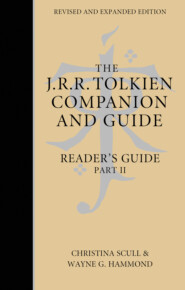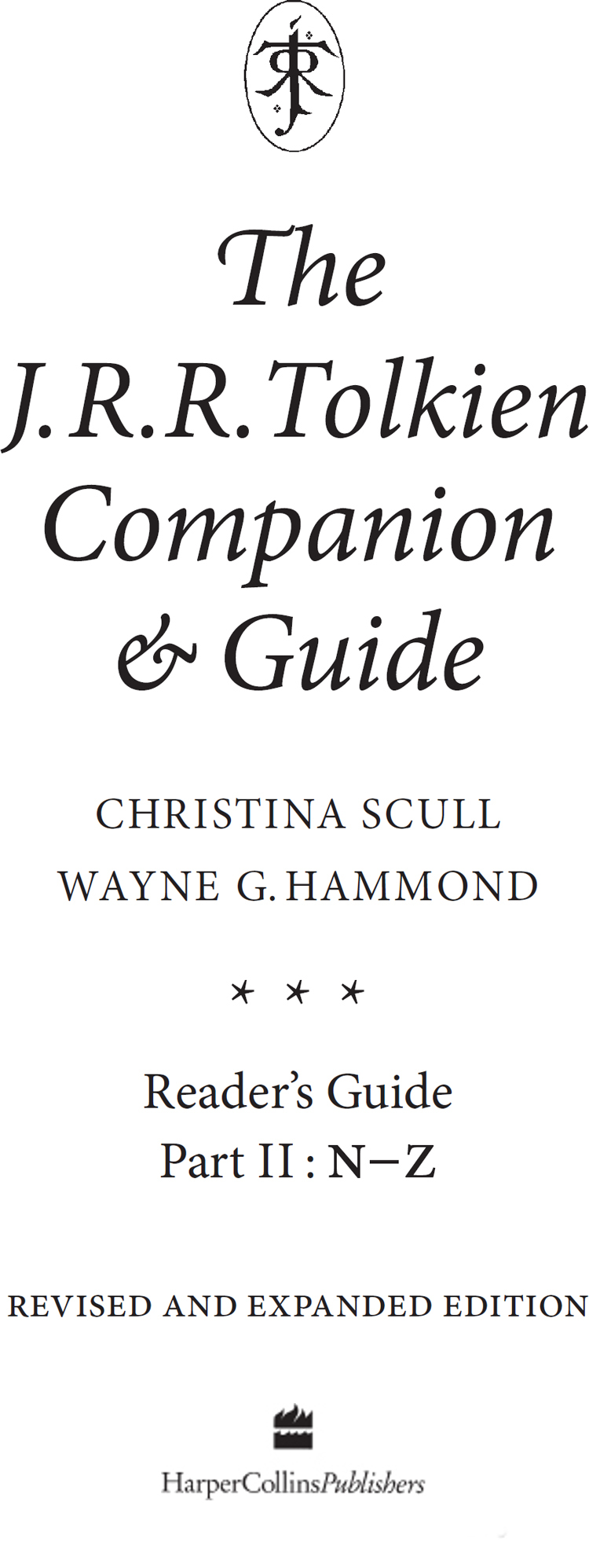
Полная версия:
The J. R. R. Tolkien Companion and Guide: Volume 3: Reader’s Guide PART 2



Copyright
HarperCollinsPublishers Ltd.
1 London Bridge Street
London SE1 9GF
www.harpercollins.co.uk
www.tolkien.co.uk
www.tolkienestate.com
Published by HarperCollinsPublishers 2017
Copyright © Christina Scull and Wayne G. Hammond 2006, 2017
Christina Scull and Wayne G. Hammond assert the moral right to be identified as the authors of this work
Further copyright information is printed at the end of the volume

A catalogue record for this book is available from the British Library
All rights reserved under International and Pan-American Copyright Conventions. By payment of the required fees, you have been granted the nonexclusive, nontransferable right to access and read the text of this ebook on-screen. No part of this text may be reproduced, transmitted, downloaded, decompiled, reverse-engineered, or stored in or introduced into any information storage and retrieval system, in any form or by any means, whether electronic or mechanical, now known or hereafter invented, without the express written permission of HarperCollins ebooks
HarperCollinsPublishers has made every reasonable effort to ensure that any picture content and written content in this ebook has been included or removed in accordance with the contractual and technological constraints in operation at the time of publication
Source ISBN: 9780008214531
Ebook Edition © November 2017 ISBN: 9780008273491
Version: 2017-10-20
Dedication
In Memory of RAYNER UNWIN Mentor and Friend
Contents
COVER
TITLE PAGE
COPYRIGHT
DEDICATION
I
PREFACE
CHRONOLOGY
NOTES
INDEX
II
PREFACE
LIST OF ARTICLES
READER’S GUIDE A–M
III
READER’S GUIDE N–Z
N
O
P
Q
R
S
T
U
V
W
X, Y, Z
FAMILY TREES
BIBLIOGRAPHIES
Published Writings & Art Poetry & Translations
WORKS CONSULTED
INDEX
ABOUT THE AUTHORS
OTHER BOOKS BY
ABOUT THE PUBLISHER
LIST OF ARTICLES
Abercrombie, Lascelles
Ace Books controversy
Acocks Green (Warwickshire)
Acta Senatus
Adaptations
The Adventures of Tom Bombadil (poem)
The Adventures of Tom Bombadil and Other Verses from the Red Book
Ae Adar Nín
Ainulindalë
Akallabêth: The Downfall of Númenor
Alcar mi Tarmenel na Erun
Aldarion and Erendis: The Mariner’s Wife
Aldershot (Hampshire)
Allegory
The ‘Alphabet of Dairon’
Aman
Ambarkanta: The Shape of the World
‘The Ambidexters Sentence’
Ancrene Riwle
Ancrene Wisse and Hali Meiðhad
Annals of Beleriand
Annals of Valinor
Appearance
An Application for the Rawlinson and Bosworth Professorship of Anglo-Saxon … Oxford
Art
The Art of The Hobbit by J.R.R. Tolkien
The Art of The Lord of the Rings by J.R.R. Tolkien
Arthur and the Matter of Britain
Athrabeth Finrod ah Andreth
Atlakviða
Atlantis
Attacks of Taste
Auden, Wystan Hugh
‘Of Aulë and Yavanna’
Authorial Presence
Barfield, Arthur Owen
Barnett, Allen
Barnsley, Thomas Kenneth
Barnt Green (Worcestershire)
Barrie, James Matthew
Barrowclough, Sidney
The Battle of Maldon
The Battle of the Eastern Field
The Battles of the Fords of Isen
Baynes, Pauline Diana
Bedford (Bedfordshire)
‘Of the Beginning of Days’
‘Of Beleriand and Its Realms’
Belgium
Bennett, Henry Stanley
Bennett, Jack Arthur Walter
Beowulf
Beowulf: A Translation and Commentary Together with The Sellic Spell
Beowulf: The Monsters and the Critics
‘Of Beren and Lúthien’
Beren and Lúthien (book)
Berkshire
Bibliographies
The Bidding of the Minstrel, from the Lay of Eärendel
Bilbo’s Last Song (at the Grey Havens)
Biographies
Birmingham and environs
Birmingham Oratory
Blackwell, Basil Henry
Bliss, Alan Joseph
‘The Bodleian Declensions’
Bombadil Goes Boating
The Book of Lost Tales
The Book of Lost Tales, Part One
The Book of Lost Tales, Part Two
Bournemouth (Hampshire)
Bowra, Cecil Maurice
Bradley, Henry
Braunholtz, Gustav Ernst Karl
Brett-Smith, Herbert Francis Brett
Brewerton, George
Brogan, Denis Hugh Vercingetorix
Brookes-Smith family
Brown, Walter Rolfe
Bryson, John Norman
Buchan, John
Buckhurst, Helen Thérèse McMillan
Burchfield, Robert William
Calligraphy
Cambridge (Cambridgeshire)
Campbell, Alistair
Campbell, Ignatius Roy Dunnachie
Carr, Charlie
Carroll, Lewis
Carter, Douglas
Cat
Cecil, Edward Christian David Gascoyne
Celtic influences
Chambers, Raymond Wilson
Chandler, Pamela
Chaucer, Geoffrey
Chaucer as a Philologist: The Reeve’s Tale
Cheddar Gorge and Caves (Somerset)
Cheltenham (Gloucestershire)
Chesterton, Gilbert Keith
Childe, Wilfred Rowland Mary
Children
The Children of Húrin (book)
Círdan
Cirion and Eorl and the Friendship of Gondor and Rohan
The City of the Gods
Classical influences
The Clerke’s Compleinte
Clevedon (Somerset)
A Closed Letter to Andrea Charicoryides … Sometimes Known as Charles Williams
Coghill, Nevill Henry Kendal Aylmer
Collecting and sales
Collingwood, Robin George
‘Of the Coming of Men into the West’
‘Of the Coming of the Elves and the Captivity of Melkor’
Common Eldarin Noun: Structure
‘Common Quendian Declension’
Comparative Tables
The Complaint of Mîm the Dwarf
Composition, Manner of
The Converse of Manwë and Eru
Cornwall
Corrected Names of Chief Valar
The Corrigan
Cowling, George Herbert
Craigie, William Alexander
The Creatures of the Earth
Criticism
Cromer (Norfolk)
Cuivienyarna
Cullis, Colin
Dagnall, Margery Kathleen Mary, known as Susan
Dangweth Pengoloð
Darbishire, Helen
D’Arcy, Martin Cyril
D’Ardenne, Simonne Rosalie Thérèse Odile
‘Of the Darkening of Valinor’
Davis, Norman
Dawkins, Richard MacGillivray
Day, Mabel Katherine
De Zulueta, Francis
Declension of Nouns
A Description of the Island of Númenor
The Devil’s Coach-Horses
The Disaster of the Gladden Fields
Walt Disney Studios
Dobson, Eric John
Domestic duties
Doworst
The Dragon’s Visit
Dragons
Drama
The Drowning of Anadûnê
Dundas-Grant, James Harold
Of Dwarves and Men
Dyson, Henry Victor Dyson
Éalá Éarendel Engla Beorhtast
Earendel at the Helm
‘Early Chart of Names’
‘Early Noldorin Grammar’
‘Early Qenya Pronouns’
Earp, Thomas Wade
Eddison, Eric Rucker
‘Of Eldamar and the Princes of the Eldalië’
Eldarin Hands, Fingers & Numerals
The Elvish Alphabets
Elvish Song in Rivendell
Emery, Augustin Robert
The End of the Third Age: The History of The Lord of the Rings, Part IV
England
English and Medieval Studies Presented to J.R.R. Tolkien …
English and Welsh
English language
‘English–Qenya Dictionary’
Enigmata Saxonica Nuper Inventa Duo
Of the Ents and the Eagles
‘The Entu, Ensi, Enta Declension’
Environment
Eriol and Ælfwine
Errantry
Escape
‘Essay on Phonetic Symbolism’
Essays Presented to Charles Williams
Etymologies
Eucatastrophe
An Evening in Tavrobel
Everett, Dorothy
Examinations
Fairbank, Christian Albert Hastings
Fairford (Gloucestershire)
Fairy-stories
The Fall
The Fall of Arthur (poem)
The Fall of Arthur (book)
The Fall of Númenor
Fandom and popularity
Farmer Giles of Ham
Farnell, Lewis Richard
Farrer, Katharine Dorothy
Fastitocalon
‘Fate and Free Will’ (notes)
Fate and free will (topic)
The ‘Father Christmas’ letters
‘Of Fëanor and the Unchaining of Melkor’
The Feanorian Alphabet
Field, Geoffrey Simpson
‘Of the Fifth Battle: Nirnaeth Arnoediad’
Filey (Yorkshire)
Finn and Hengest: The Fragment and the Episode
Firth, Charles Harding
‘Five Late Quenya Volitive Inscriptions’
The Five Wizards
Fletcher, Ronald Frank William
‘Flight of the Gnomes’
The Flight of the Noldoli from Valinor
‘Of the Flight of the Noldor’
Folkestone (Kent)
Food and drink
For W.H.A.
A Fourteenth-Century Romance
Fox, Adam
France
Fraser, John
Freston, Hugh Reginald
From the Many-Willow’d Margin of the Immemorial Thames
Gardner, Helen Louise
Gawain’s Leave-taking
Gedling (Nottinghamshire)
‘Gerald of Wales on the Survival of Welsh’
Gilson, Robert Cary
Gilson, Robert Quilter
Glip
Glorfindel
‘The Gnomes Come to the Great Lands’
Gnomish Grammar
Gnomish Lexicon
‘The Gnomish Lexicon Slips’
Goblin Feet
‘Goldogrin Pronomial Prefixes’
Gollins, Annie
Good and Evil
Gordon, Eric Valentine
Gordon, George Stuart
Gordon, Robert Hope
Grahame, Kenneth
Great Haywood (Staffordshire)
Green, Roger Gilbert Lancelyn
The Grey Bridge of Tavrobel
Griffiths, Mary Elaine
Grove, Mary Jane, known as Jennie
Habbanan beneath the Stars
Haggard, Henry Rider
Hall, William Ernest
Halsbury, John Anthony Hardinge Giffard, Earl of
The Happy Mariners
Hardie, Colin Graham
Harrogate (Yorkshire)
Havard, Robert Emlyn
Health
The Heirs of Elendil
Henry Bradley, 3 Dec., 1845–23 May, 1923
‘Heraldic Devices of Tol Erethrin’
Hill, Margaret Joy
Historical and cultural influences
The History of Galadriel and Celeborn and of Amroth King of Lórien
The History of Middle-earth
The History of The Hobbit
The History of The Lord of the Rings
The Hoard
The Hobbit
Holy Maidenhood
The Homecoming of Beorhtnoth Beorhthelm’s Son
Hope and despair
The Horns of Ylmir
Hove (Sussex)
The Hunt for the Ring
Illustration
Imram
Incledon family
‘Index of Names for The Lay of the Children of Húrin’
The Inklings
‘Introduction to the “Elder Edda”’
Ireland, Republic of (Eire)
The Istari
Italy
‘Iþþlen’ in Sawles Warde
J.R.R. Tolkien: Artist and Illustrator
J.R.R. Tolkien’s Letters to Rhona Beare
Jennings, Elizabeth Joan
The Jerusalem Bible
Jones, Gwyn
Kainendan
Kalevala (including The Story of Kullervo)
Katherine Group
Ker, Neil Ripley
King Edward’s School, Birmingham
‘The Koivienéni Manuscript’
Lancashire Fusiliers
Lang, Andrew
Languages
Languages, Invented
Lascelles, Mary Madge
The Last Ark
The Last Ship
Laws and Customs among the Eldar
The Lay of Aotrou and Itroun (poem)
The Lay of Aotrou and Itroun (book)
The Lay of Beowulf
‘Lay of Eärendel’
Lay of Leithian
The Lay of the Children of Húrin
The Lay of the Fall of Gondolin
The Lays of Beleriand
Lea, Kathleen Marguerite
Leaf by Niggle
Leeds (Yorkshire)
Leeds, University of
Leeds University Verse, 1914–24
The Legend of Sigurd and Gudrún (including Völsungakviða en nýja and Guðrúnarkviða en nýja)
Of Lembas
The Letters of J.R.R. Tolkien
Lewis, Clive Staples
Lewis, Warren Hamilton
Lhammas
Libraries and archives
Light
Light as Leaf on Lindentree
Lincoln (Lincolnshire)
The Line of Elros: Kings of Númenor
The Little House of Lost Play: Mar Vanwa Tyaliéva
London
The Lonely Isle
The Lord of the Rings
Loss
The Lost Road (story)
The Lost Road and Other Writings
Lyme Regis (Dorset)
McCallum, Ronald Buchanan
MacDonald, George
McFarlane, Kenneth Bruce
McIntosh, Angus
Mackreth, John
Madlener, Josef
‘Of Maeglin’
Of Maeglin: Sister-son of Turgon, King of Gondolin
Magic
Malvern (Worcestershire)
The Man in the Moon Came Down Too Soon
The Man in the Moon Stayed Up Too Late
MS. Bodley 34: A Re-Collation of a Collation
Maps
Mary Michael
Masefield, John Edward
Massiah-Palmer, Werner William Thomas
‘Matar and Tulir’
Mathew, Anthony Gervase
Measures, Alfred Ernest
Melkor Morgoth
‘Of Men’
The Mewlips
Middle English ‘Losenger’
A Middle English Vocabulary
Milford-on-Sea (Hampshire)
Mills, Stella Marie
Mr. Bliss
Mitchison, Naomi Mary Margaret
Mitton family
The Monsters and the Critics and Other Essays
Morgan, Francis Xavier
Morgoth’s Ring: The Later Silmarillion, Part One: The Legends of Aman
Morris, William
Mortality and immortality
Mountain family
Murray, Robert Patrick Ruthven
Music
Mythopoeia
‘Name-list to The Fall of Gondolin’
The Name ‘Nodens’
The Nameless Land
Names
Names and Required Alterations
‘Names of the Valar’
Napier, Arthur Sampson
Narn i Chîn Húrin
Narqelion
Nature
Neave, Emily Jane
Nesbit, Edith
Netherlands
A New Glossary of the Dialect of the Huddersfield District
The New Shadow
Newby, Percy Howard
Newcastle upon Tyne
Nichol Smith, David
Nieninque
Noel
‘Of the Noldor in Beleriand’
‘Noldorin Dictionary’
‘Noldorin Word-Lists’
Nomenclature of The Lord of the Rings
A Northern Venture
Northernness
Notes for Qenya Declensions
Notes on Motives in the Silmarillion
‘Notes on Óre’
The Notion Club Papers
Nouns
Númenor
Númenórean Linear Measures
Official Name List
The Old English Apollonius of Tyre
The Old English Exodus
‘Old English Verse’
Oliphaunt
On Ælfwine’s Spelling
On Fairy-Stories
On ‘The Kalevala’ or Land of Heroes
Once upon a Time
Onions, Charles Talbut
Orcs
Otley (Yorkshire)
Otsan
Over Old Hills and Far Away
Oxford and environs
Oxford, University of
Oxford English Dictionary
Oxford English Monographs
Oxford English School (topic)
The Oxford English School (essay)
Oxford Letter
Oxford Poetry 1915
The Palantíri
Payton, Ralph Stuart
Payton, Wilfrid Hugh
Pearl
The Peoples of Middle-earth
Perry-the-Winkle
Philology
Pictures by J.R.R. Tolkien
Pity and mercy
‘The Plotz Declension’
Poems and Stories
The Poetic and Mythologic Words of Eldarissa
Poetry
Political thought
Poole (Dorset)
Possessiveness
Power
Prefatory Remarks on Prose Translation of ‘Beowulf’
Prejudice and racism
Primitive Quendian Structure
Princess Mee
The Princess Ní
‘The Problem of Lhûn’
The Problem of Ros
Progress in Bimble Town
The Prophecy of the Sibyl
Publishers
Qenya: Descriptive Grammar of the Qenya Language
‘Qenya Conjugations’
‘Qenya Declensions’
Qenya Grammar
The Qenya Verb Forms
‘Qenya Word-Lists’
Qenyaqetsa
Quantock Hills (Somerset)
Quendi and Eldar
Quenta Noldorinwa
Quenta Silmarillion (1930s–1950s)
‘Quenta Silmarillion’
Quenya: Outline of Phonology
Quenya Verb Structure
Quest
The Quest of Erebor
Raleigh, Walter Alexander
Ransome, Arthur Michell
Rattenbury, R.M.
Reade, Francis Vincent
Reading
Realities: An Anthology of Verse
Recordings
Recovery



